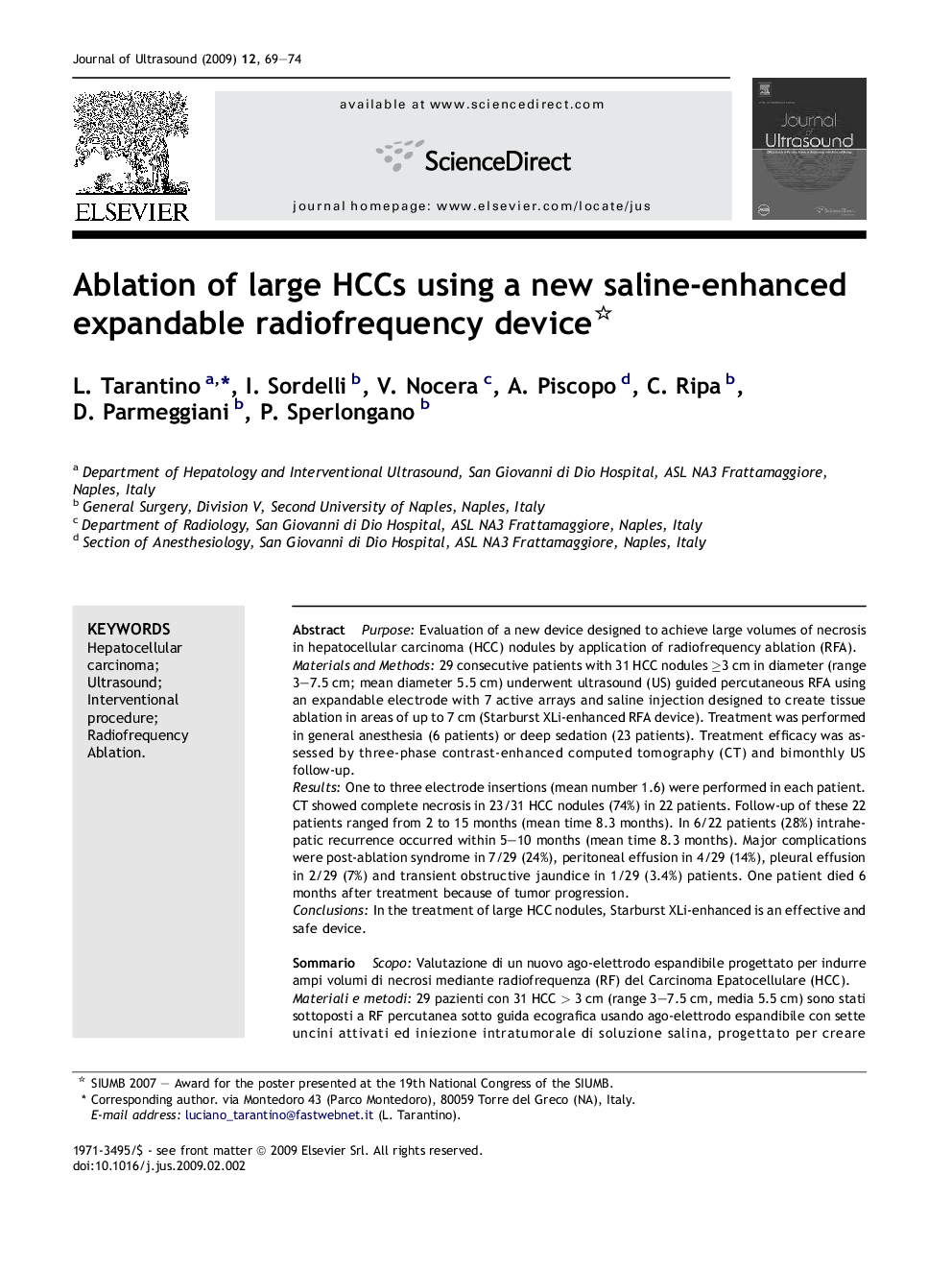| Article ID | Journal | Published Year | Pages | File Type |
|---|---|---|---|---|
| 4236941 | Journal of Ultrasound | 2009 | 6 Pages |
PurposeEvaluation of a new device designed to achieve large volumes of necrosis in hepatocellular carcinoma (HCC) nodules by application of radiofrequency ablation (RFA).Materials and Methods29 consecutive patients with 31 HCC nodules ≥3 cm in diameter (range 3–7.5 cm; mean diameter 5.5 cm) underwent ultrasound (US) guided percutaneous RFA using an expandable electrode with 7 active arrays and saline injection designed to create tissue ablation in areas of up to 7 cm (Starburst XLi-enhanced RFA device). Treatment was performed in general anesthesia (6 patients) or deep sedation (23 patients). Treatment efficacy was assessed by three-phase contrast-enhanced computed tomography (CT) and bimonthly US follow-up.ResultsOne to three electrode insertions (mean number 1.6) were performed in each patient. CT showed complete necrosis in 23/31 HCC nodules (74%) in 22 patients. Follow-up of these 22 patients ranged from 2 to 15 months (mean time 8.3 months). In 6/22 patients (28%) intrahepatic recurrence occurred within 5–10 months (mean time 8.3 months). Major complications were post-ablation syndrome in 7/29 (24%), peritoneal effusion in 4/29 (14%), pleural effusion in 2/29 (7%) and transient obstructive jaundice in 1/29 (3.4%) patients. One patient died 6 months after treatment because of tumor progression.ConclusionsIn the treatment of large HCC nodules, Starburst XLi-enhanced is an effective and safe device.
SommarioScopoValutazione di un nuovo ago-elettrodo espandibile progettato per indurre ampi volumi di necrosi mediante radiofrequenza (RF) del Carcinoma Epatocellulare (HCC).Materiali e metodi29 pazienti con 31 HCC > 3 cm (range 3–7.5 cm, media 5.5 cm) sono stati sottoposti a RF percutanea sotto guida ecografica usando ago-elettrodo espandibile con sette uncini attivati ed iniezione intratumorale di soluzione salina, progettato per creare un'ablazione tessutale fino a 7 cm (Starburst XLi-enhanced, Angiodynamics, Queensbury, NY, USA). Il trattamento è stato condotto in anestesia generale (6 pazienti) o in sedazione profonda (23 pazienti). L'efficacia del trattamento è stata valutata con TC trifasica e con follow-up ecografico ogni 2 mesi.RisultatiSono state praticate da 1 a 3 inserzioni (media 1.6) per paziente. La necrosi completa alla TC è stata raggiunta in 23/31 noduli di HCC (74%) in 22 pazienti. Il follow-up di questi 22 pazienti è compreso tra 2 e 15 mesi (media 8.3 mesi). 6/22 pazienti (28%) hanno presentato nuove recidive intraepatiche entro 5–10 mesi (media 8.3 mesi). Complicanze maggiori sono state: sindrome post-ablativa in 7/29 (24%), versamento peritoneale in 4/29 (14%), versamento pleurico in 2/29 (7%) e ittero ostruttivo transitorio in 1/29 (3.4%) pazienti. Un paziente è deceduto 6 mesi dopo il trattamento per la progressione del tumore.ConclusioniL'Ago-elettrodo Starburst XLi-enhanced ad infusione salina è un dispositivo efficace e sicuro per il trattamento del carcinoma epatocellulare di grandi dimensioni.
